Maybe you’ve heard of Montana’s Grizzly Bears, but did you know that rattlesnakes, mountain lions, bobcats, and black widows also call Montana home?
What other dangerous animals live in Montana? Do they live in the water or on land? And how can you avoid them?
In this article, we list the 11 most dangerous animals in Montana to look out for and stay away from. Discover which regions of Montana they call home and how to identify them, and find some tips on how to react if you ever encounter one.
The best tip is to carry bear spray with you at all times and avoid these animals at all costs.
In this article:
- Grizzly Bear
- Bobcat
- Mountain Lion
- Prairie Rattlesnake
- Wolverine
- Wolf
- Bison
- Black Bear
- Moose
- Black Widow
- Tick
What makes wildlife dangerous in Montana?
What makes a wild animal dangerous in Montana? Is it their size and weight? Claws and teeth? A venomous or disease-ridden bite? The most dangerous animals in Montana have each of these features.
Montana’s Grizzly Bears are enormous, fast, and have sharp claws and pointed teeth. Rattlesnakes are small, but they’re lightning-fast and their bite can be fatal. Neither seek out humans, but they have an incomparable advantage if they are startled and jump into a defensive attack.
What is Montana’s deadliest animal?
The Grizzly Bear is arguably Montana’s most deadly animal. They have enormous power, high speed, sharp claws, and pointed teeth. While Grizzly Bears don’t prey on humans, their size, power, and protective nature make them Montana’s deadliest animal, especially when startled or protecting their cubs.
What are the most dangerous animals in Montana?
15 most dangerous animals in Montana
Here are the 15 most dangerous animals to look out for in Montana.
1. Grizzly Bear
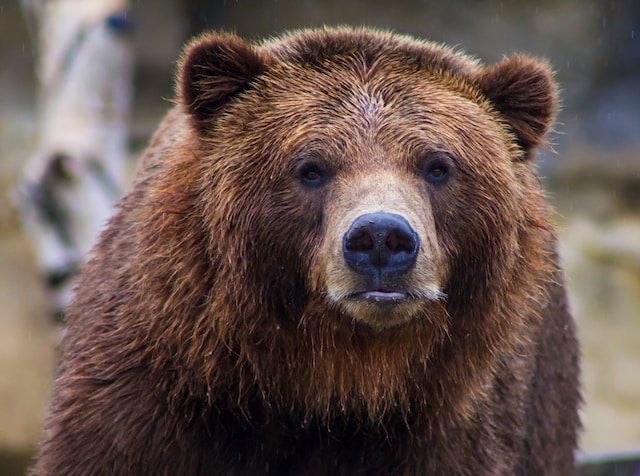
Quick facts:
- Class: Mammal
- Max speed: 35 mph (56 km/h)
- Height: 1 m
- Diet: Omnivore
- Weight:
- Male adult: 595 lbs (270 kg)
- Female adult: 287 – 440 lbs (130 – 200 kg)
- ID markers: Bump behind the head between the shoulders; hind lower than shoulders; dip between eyes and end of snout; short, round ears
- Habitat: Western Montana, Rocky Mountains
Montana’s Grizzly Bear is a subspecies of the brown bear. Grizzly Bears are native to the western US and Canada. They’re recognizable by the large bump between their shoulders – should you ever see a bear in the wild with this bump, you’ll know it’s a grizzly.

Grizzly bears are easily the most dangerous animal in Montana. While they don’t seek out humans, there is a large population of them across western Montana and they attack if they are startled or if a mother feels her cubs are threatened.
Unlike other predatory animals, grizzlies prefer to spend their time hunting alone in the woods. They value their space, which makes them more aggressive should they be surprised.
Grizzly attacks common in Montana and they are no joke, as they are often fatal.
Best defense against Grizzly Bears: BEAR SPRAY & BEAR BELLS
Hands down, the best way to protect yourself from a grizzly bear is by using bear spray. And using bear bells helps you avoid an encounter in the first place:
- Bear bells make noise, notifying bears in the area of your presence, so you can avoid surprising one and triggering an attack.
- Bear spray is like pepper spray, but stronger and has a 35 ft (11 m) range. When sprayed in the face it neutralizes the bear, allowing you to escape – seriously, this stuff works.
Keep a can of bear spray outside your pack (ex. in a water bottle pouch) so you can quickly draw it.
Bear spray is extremely effective, and neither spray nor bells are expensive – this can of bear spray on Amazon is from a reliable brand at a reasonable price.
Here’s a set of bear bells on Amazon from a top brand. Their built-in magnetic silencer is really useful for when you’re at home, packing up for the hike.
Remember:

What to do if you encounter a Grizzly Bear [VIDEO]
Here’s a quick rundown of how to prevent bear encounters and what to do if you ever come across one:
Do bear bells really work? Find out here
2. Bobcat

Quick facts:
- Class: Mammal
- Max speed: 30 mph (48 km/h)
- Height: 1.5 – 2 ft (46 – 64 cm)
- Diet: Carnivore
- Weight:
- Male adult: 14 – 40 lbs (6.4 – 18 kg)
- Female adult: 9 – 34 lbs (4 – 15 kg)
- ID markers: Reddish-brown fur; white underbelly; black spots all over; short tail
- Habitat: Statewide; in areas with dense vegetation and high prey density
Bobcats, also called Red Lynx, are native to North America and are one of the most dangerous animals in Montana. They often feature black bars down their forelegs and their name stems from their short, black-tipped bobbing tail.
Their prime habitats include swamps, semideserts, forests, and urban edges, and they create dens inside caves, dark spaces between rocks, hollow logs, or abandoned manmade structures. Their habitat includes the entire western region of Montana.
These ferocious predators have keen hearing, sharp vision, and an acute sense of smell, and they prey on smaller animals. Bobcats are one of the most dangerous animals in Montana, but if left alone, they aren’t usually a threat. Bobcat attacks are almost unheard of, however, these creatures are extremely dangerous if provoked or disturbed.
What’s the difference between Wyoming and Montana? Find out here.
3. Mountain Lion
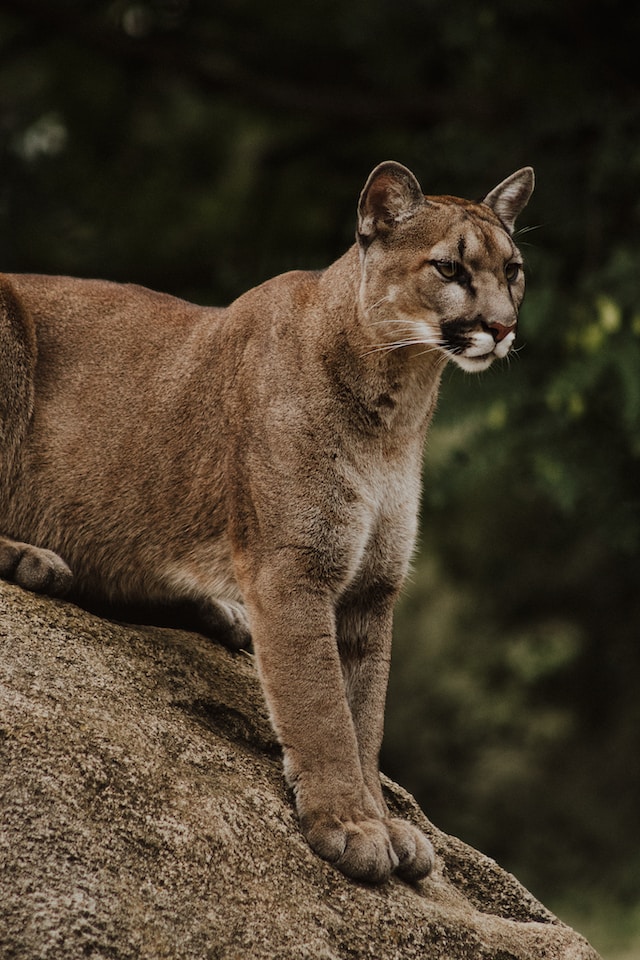
Quick facts:
- Class: Mammal
- Max speed: 30 mph (64 – 80 km/h)
- Height: 24 – 35 ft (60 – 90 cm)
- Diet: Carnivore
- Weight:
- Male adult: 116 – 220 lbs (53 – 100 kg)
- Female adult: 64 – 141 lbs (29 – 64 kg)
- ID markers: Tan fur; white underbelly; black on back of ears; black tail tip
- Habitat: Statewide; in brushy and dense thickets and open areas
Mountain Lions are enormous cats that grow up to 7 ft long (2.1 m) and reach up to 220 lbs (100 kg), bigger than a large dog. These creatures are nocturnal, though they can attack during the day. They are easily one of the most dangerous animals in Montana, though they rarely prey on humans.
One thing that makes Mountain Lions so spooky is that they’re known for stalking their prey, unbeknownst to the prey. Their presence can go unnoticed.
How to avoid Mountain Lion encounters
Never hike alone. Cougars are more likely to avoid large groups of hikers making noise than someone quietly hiking alone. Most importantly, make noise while hiking, so as not to startle them (bear bells work for mountain lions to some degree, but they don’t offer much guarantee).
What to do if you cross a mountain lion
If you do encounter one, do not run!
- Talk calmly to it
- Avoid eye contact
- Back away slowly
If an attack appears imminent, make yourself look as big as possible, put your hands up in the air, yell at it, throw rocks, blow an air horn, and do not crouch down.
Is Montana safe? Find out here
4. Prairie Rattlesnake
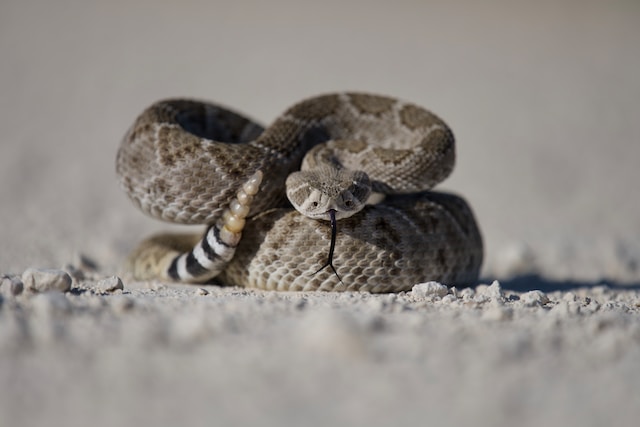
Quick facts:
- Class: Reptile
- Max speed: 8 ft/s (5mph, 8 km/h)
- Length: 35 – 45 in (89 – 114 cm)
- Diet: Carnivore
- Weight: 2 lbs (1kg)
- ID markers: Tan in color; dark bands or blotches down the back; dark olive or brown tail rings
- Habitat: Statewide; in open and dry areas; on south-facing slopes and rocky outcrops
The Prairie Rattlesnake is the only poisonous, venomous snake in Montana, and it lives in the lower elevations of the state. It is of the tamest species of rattlesnakes and enjoys bathing on warm rocks in the summer. The sound of its rattle is enough to notify you of its presence so you can back away.
Nonetheless, their incredible camouflage makes them extremely difficult to spot and hikers often stumble upon them before they hear the rattle. If you’re walking or hiking outdoors during the warm summer months, be especially careful where you place your feet and hands. Use walking sticks to push back the brush and check for snakes while walking.
They are one of the several poisonous animals in Montana, and their venomous bite easily makes them one of the most dangerous animals in Montana.
What to do if you see a rattlesnake
If you hear that distinctive rattle:
- Immediately stop
- Locate the snake
- Slowly back away from it
While backing away, place your walking stick in the ground between you and the snake so it can hit the stick if it decides to strike.
Symptoms of a rattlesnake bite
- Pain
- Swelling
- Bruising
- Trouble breathing
- Minty, metallic taste in the mouth
- Numbness
- Signs of shock
If bitten, call 911 (or your local emergency line) and seek treatment immediately.
Do you like small towns? Discover Dillon, one of Montana’s most charming towns
5. Wolverine
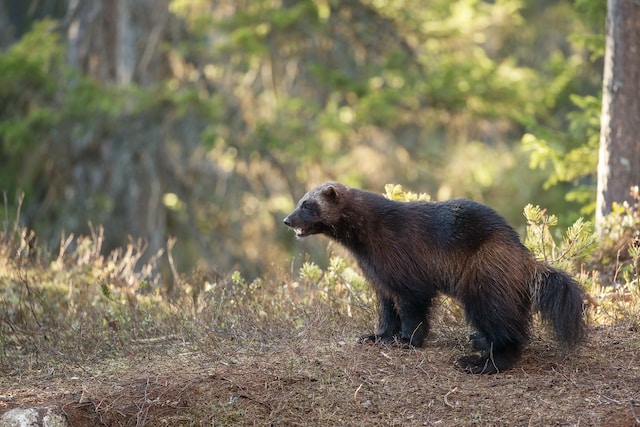
Quick facts:
- Class: Mammal
- Max speed: 30 mph (64 – 80 km/h)
- Length: 31 – 51 in (79 – 130 cm)
- Diet: Carnivore
- Weight: 35 – 60 lbs (16 – 27 kg)
- ID markers: Like a small dark brown or black bear with a long tail (the size of a medium-sized dog); stocky body; blond or light brown on the forehead and sides
- Habitat: Coniferous (pine, etc.) forests of the Rocky Mountains
Are there wolverines in Montana? Some people are surprised to hear that there are wolverines in Montana. And while they are small, even cute-looking creatures, they are easily one of the most dangerous animals in Montana.
What makes them such a threat? Wolverines are notoriously territorial and aggressive in nature. Their home territory can reach up to 600 mi2 (1,554 km2) and they don’t hesitate to attack if another creature enters it.
They generally live in the western part of Montana and prefer the higher, mountainous regions in the summer and lower regions in the winter. They stick to wooded, untouched areas that haven’t been cleared by fire and clear-cutting or disturbed by roads. While wolverine attacks are rare, it’s best to be on the lookout and stay clear of these territorial creatures.
Discover the 10 best ghost towns in Montana
6. Wolf
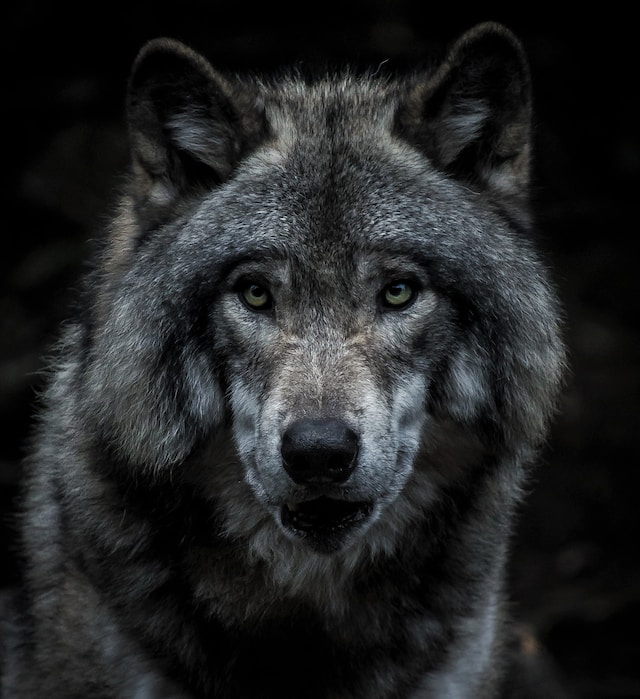
Quick facts:
- Class: Mammal
- Max speed: 40 mph (64 km/h)
- Height: 2.5 ft (76 cm)
- Diet: Carnivore
- Weight:
- Male adult: 80 – 110 lbs (36 – 50 kg)
- Female adult: 75 – 90 lbs (34 – 41 kg)
- ID markers: Black or grey fur; shorter, more rounded ears and bushier tails than a coyote
- Habitat: Statewide
Wolves are a protected species in Montana that plays an incredibly important role in the balance of the local and surrounding ecosystem. They’re carefully managed by Montana Fish, Wildlife, and Parks.
They are ferocious animals when on the hunt, and usually hunt in packs to take down larger prey. Wolves are easily one of the most dangerous animals in Montana, but fortunately, wolf attacks on humans here are extremely rare.
It’s quite common to hear wolfpacks howling in the middle of the night when you’re out camping – a beautiful, but unsettling sound.
7. Bison
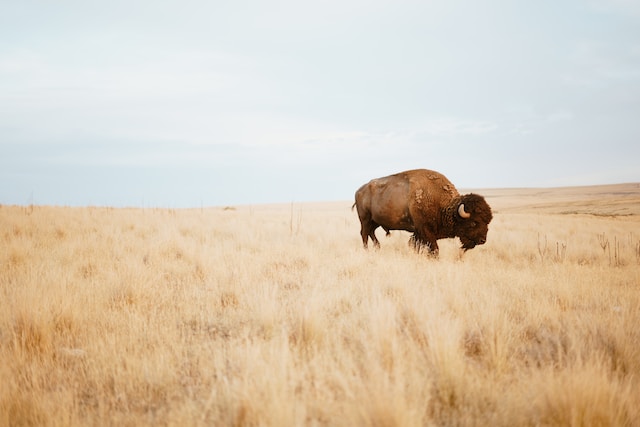
Quick facts:
- Class: Mammal
- Max speed: 35 mph (56 km/h)
- Height: 4 – 6 ft (1.2 – 1.8 m)
- Diet: Herbivore
- Weight:
- Male adult: 2,000 lbs (907 kg)
- Female adult: 1,000 lbs (454 kg)
- ID markers: Dark brown; darker head than body; shaggy fur; robust shoulders; thinner hind; short horns
- Habitat: Yellowstone National Park and the National Bison Refuge
Bison are native to Montana and have played an integral role in the lives of native North American tribes since long before Europeans first set foot on the continent. They have a formidable appearance: thick, bushy fur, stout noses, robust shoulders, and thick mid-quarters. They carry a lot of weight and are extremely fast.
Bison roam only in protected areas in Montana, such as the National Bison Range and Yellowstone National Park. They are furry, prominent, and beautiful creatures that have no claws or jagged teeth and are often standing or slowly roaming the plains in enormous herds. Due to their calm appearance, people often don’t associate them with aggression.
Nonetheless, they are one of the most dangerous animals in Montana. They are territorial and protective animals with extreme power that will attack if they feel threatened. If you see a bison calmly chewing away at the grass or crossing the road seemingly undisturbed by its surroundings, do not approach it. Stay in your car.
Sadly, bison attacks are common in Montana and often fatal.
Discover the National Bison Range in Montana
8. Black Bear
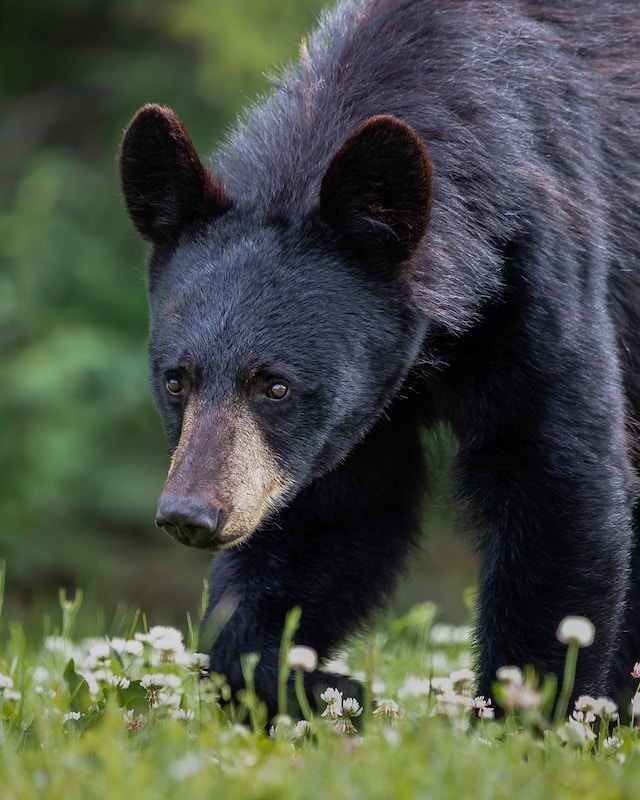
Always steer clear of black bears.
Quick facts:
- Class: Mammal
- Max speed: 30 mph (5486 km/h)
- Height: 3 ft (91 cm)
- Diet: Omnivore
- Weight:
- Male adult: 130 – 661 lbs (59 – 300 kg)
- Female adult: 90 – 174 lbs (41 – 79 kg)
- ID markers: Black fur; shoulder flat with back (almost no bump); hind higher than shoulders; taller ears than Grizzlies (oval-shaped)
- Habitat: Statewide; rarely in the northeast
Black bears are the smallest bear of their species and much less often associated with aggression. Nonetheless, these are still bears. Bears are one of the most dangerous animals in Montana that can easily be aggressive if they are hunting for food or if you stumble upon a mother with her cubs.
While black bears are relatively small, don’t let their size confuse you – they are large, territorial predators that outpower a human by a large margin and will attack under certain circumstances.
Most bear attacks in Montana involve mothers protecting their cubs or their food. Nonetheless, bear attacks are common in Montana.
What to do if you see a black bear
- Make yourself appear big by standing tall, unzipping your jacket, and spreading your arms above your head
- Don’t make eye contact with it, as this can be seen as a threat.
- Never cross between a mother and her cubs.
- Don’t run – slowly back away until the bear is out of sight.
Remember to always carry bear spray with you when out and about in Montana.
Discover the 5 best ski resorts in Montana
9. Moose
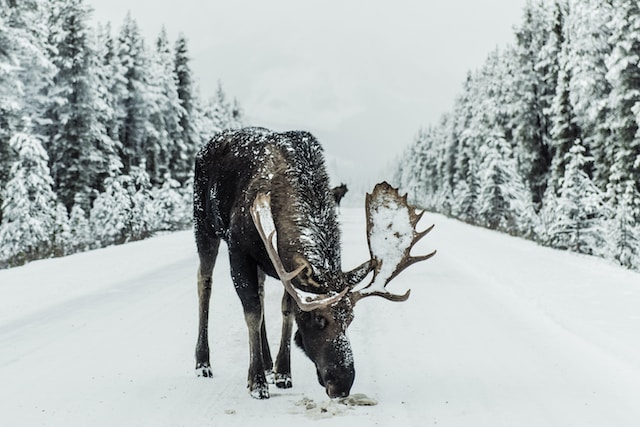
Quick facts:
- Class: Mammal
- Max speed: 35 mph (56 km/h)
- Height: 4 – 7 ft (1.4 – 2.1 m)
- Diet: Herbivore
- Weight:
- Male adult: 838 – 1,543 lbs (380 – 700 kg)
- Female adult: 441 – 1,080 lbs (200 – 490 kg)
- ID markers: Dark brown; tall legs; large body; palm-like antlers; long and overhanging snout
- Habitat: Forested areas of Western Montana
If you think Moose look like gentle creatures, you’re partially right. They don’t have sharp claws or jagged teeth, and they aren’t aggressive predators on the hunt. They are herbivores often seen roaming forested areas of western Montana, rather than dashing through the hills in search of prey.
But they have enormous size, extreme power, and a large rack of antlers. When moose feel threatened, they charge hard and fast in all conditions, even through deep snow. Their long legs can glide through several feet of thick snow like it’s not there, giving them an incredible advantage to attack or escape in almost any situation, year-round.
While moose are dashing animals, icons of Montana, and an extraordinarily beautiful sight, they are one of the most dangerous animals in Montana. Moose attacks do occur in the state. If you come across one, please give it plenty of space – if it feels threatened, it will react.
Have a look at this moose bolting through several feet of snow as if it’s a light dusting:
Warning signs that a moose feels threatened and may become aggressive
- Lip smacking
- Urinating
- Head tossing
- Pulling back their ears
- Raised neck hair
What to do if you see a Moose
- Stop
- Don’t feed it
- Give it space
- Keep your dogs close by
- Never pass between a cow and her calf
Take a long route around it.
What’s life really like where Yellowstone is filmed? Discover Darby, Montana
10. Black Widow
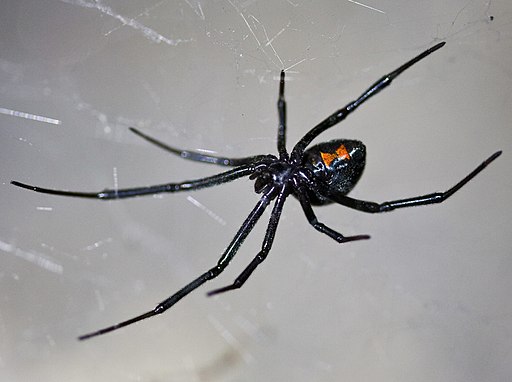
Quick facts:
- Class: Arachnid
- Length: 12 – 13 mm
- Diet: Carnivore
- Weight: 0.035 oz (1 g)
- ID markers: Black body; red hourglass on underside of abdomen
- Bite symptoms: Persistent sweating, muscle cramping, and other neurological responses
- Habitat: Dark areas with low traffic, such as cellars, garages, and sheds
The black widow is a harrowing-looking spider. Their bodies are pitch black with a red, hourglass shape on their underside. As frightful as these spiders appear, they generally avoid humans and are not aggressive if not disturbed, unless it is a mother protecting her eggs.
They usually take up home in crawl spaces, garages, basements, or any dark area that isn’t frequented by people. Take extra caution when in these areas, because if you disturb one of them, they will bite.
Black widows are one of the most dangerous animals in Montana. Their bites cause Latrodectism, which results in muscle cramping, persistent sweating, and various neurological responses.
*A note on Brown Recluse: Another spider, the Brown Recluse, is often considered one of the most venomous spiders in Montana. According to Montana State University, Brown Recluse spiders are not native to Montana, and their venom does not cause body-wide or systemic reactions. However, their bites can create an entry point for infection.
11. Tick (American dog tick & Rocky Mountain wood tick)
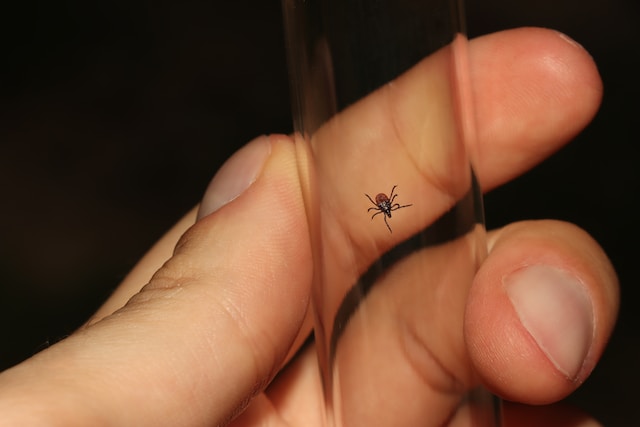
Quick facts:
- Class: Arachnid
- Length: 3 – 5 mm
- Diet: Carnivore
- ID markers: Brown, black, reddish-brown, yellowish, or grayish-white in color; flat oval shape; body much larger than head; adults have eight legs, nymphs have six legs
- Habitat: Statewide; wooded areas, grass or brush, where woods and lawn meet; in soil litter, beneath ground-cover plants, on stone walls, and in woodpiles where small animals live
These little insects may not appear threatening, but the effects of their bite can be devastating, which easily makes them one of the most dangerous animals in Montana.
Ticks are most active in the spring and summer months. Whenever you’re out walking in nature during the summer, especially rubbing up against bushes or walking beneath tree limbs, always check for ticks when you return home.
Tick bites can cause a variety of diseases, such as Lyme disease and Rocky Mountain spotted fever, and symptoms include fever, muscle pain, headache, vomiting, kidney failure, and shock, and can be fatal if left untreated.
*Note: Some tick-related disease symptoms appear later, which can be hard to trace back to the bite. These symptoms can reflect those of other diseases. If you’re ever experiencing ANY type of neurological problem or what seems to be an autoimmune disease, get tested for Lyme disease to ensure it’s not the culprit.
Dangerous-looking animals in Montana not to be worried about
1. Pronghorn
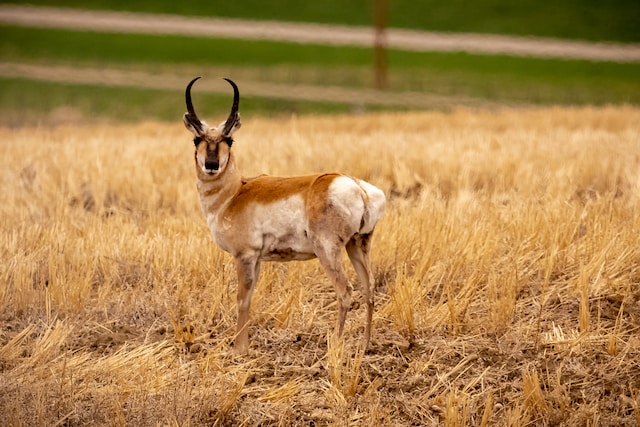
Quick facts:
- Class: Mammal
- Max speed: 61 mph (98 km/h)
- Height: 2.7 – 3.3 ft (81 – 100 cm)
- Diet: Herbivore
- Weight:
- Male adult: 18 – 143 lbs (40 – 65 kg)
- Female adult: 15 – 106 lbs (34 – 48 kg)
- ID markers: Reddish-brown or tan; two white bands across the neck; white tail and sides
- Male: black jaw patch, curved horns with a single forward prong
- Female: Very short horns that are rarely pronged
- Habitat: Grasslands and sagebrush of southwest Montana
Pronghorn look like deer, with distinct white patches on their tail and sides. Their short, backward-slanting antlers are also different from the larger antlers of deer. While their antlers may look intimidating, they are not one of the dangerous animals of Montana.
Their dynamic appearance may be frightening, but these animals generally run away when they see humans. They can reach speeds of up to 55 mph (__ km/h)
2. Deer
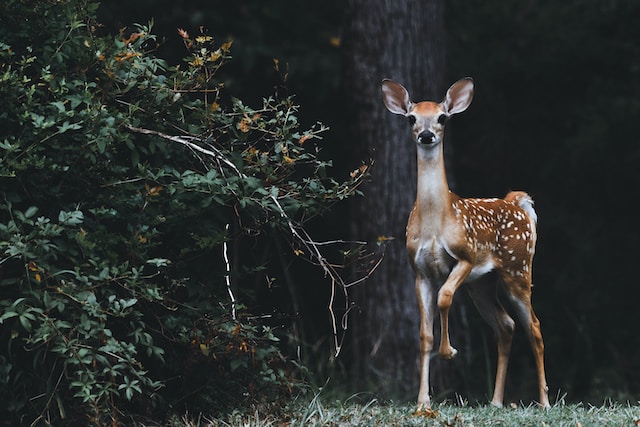
Quick facts:
- Class: Mammal
- Max speed: 37 – 50 mph (60 – 80 km/h)
- Height: 2.8 – 5 ft (85 – 150 cm)
- Diet: Herbivore
- Weight:
- Male adult: 120 – 160 lbs (54 – 73 kg)
- Female adult: 80 – 120 lbs (36 – 54 kg)
- ID markers: Reddish-brown,blue-grey, or tan fur; white tail; tall ears; single beam antlers with tines branching from it
- Habitat: Statewide
Deer are not one of the most dangerous animals in Montana. They are beautiful, mostly innocent creatures, that you don’t have to fear. They usually dash away at the first sight of a human.
However, there is one major issue with deer – they often cross roads and highways, creating major problems for drivers. Be on the alert for deer when driving Montana’s highways.
3. Garter snake
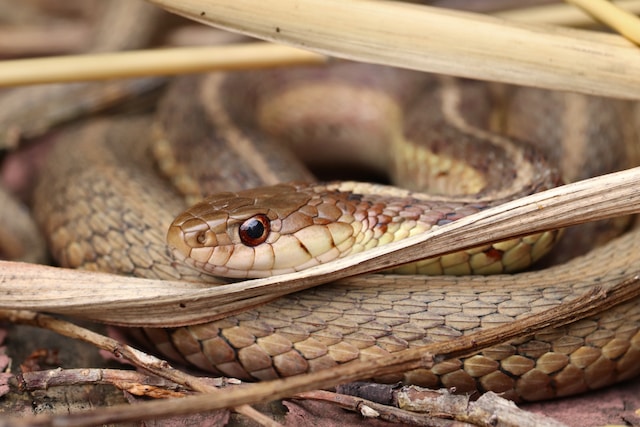
Quick facts:
- Class: Reptile
- Max speed: 1 mph (1.6 km/h)
- Length: 20 – 30 in (150 cm)
- Diet: Carnivore
- Weight: 5.3 oz (150 g)
- ID markers: Black, brown, gray, or olive body; three light white, yellow, greenish, blue, or brown stripes running the length of the body
- Habitat: Statewide; in woods, fields, and brush
Garter snakes are not one of the venomous snakes in Montana. You can find garter snakes all across Montana in woods, fields, brush piles, and similar places.
Seeing a small garter snake dart through the brush can startle you, but you have nothing to fear. They are mostly harmless and generally speed away the moment they spot a human.
However, their bites may cause an allergic reaction or create an entry point for infection. Keep children and pets away.
FAQ – Dangerous animals in Montana
What dangerous animals live in the water in Montana?
There are no dangerous animals that live in the water in Montana. The only dangerous animal that you can find in the water in Montana is the Prairie Rattlesnake, which doesn’t live in the water but isn’t averse to it. You may find one swimming in a lake or reservoir.
What state has the most dangerous animals?
One study analyzing reported animal attacks across the United States found that Texas has had the most attacks since 2000. California, Florida, and North Carolina came in second, third, and fourth respectively.


